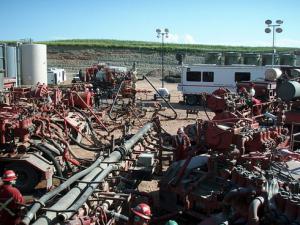Water securityGroundwater quality changes alongside the expansion of hydraulic fracturing and horizontal drilling
New research demonstrates that groundwater quality changes alongside the expansion of horizontal drilling and hydraulic fracturing but also suggests that some potentially hazardous effects may dissipate over time. The research is the first to analyze groundwater quality in the Cline Shale region of West Texas before, during, and after the expansion of hydraulic fracturing and horizontal drilling.

Study suggests water polluted by fracking dissipates is temporary // Source: commons.wikimedia.org
New research from the University of Texas at Arlington demonstrates that groundwater quality changes alongside the expansion of horizontal drilling and hydraulic fracturing but also suggests that some potentially hazardous effects may dissipate over time.
The new research, published today in the journal Science of the Total Environment is the first to analyze groundwater quality in the Cline Shale region of West Texas before, during, and after the expansion of hydraulic fracturing and horizontal drilling.
UTA says that the research team collected and analyzed private water well samples on the eastern shelf of the Permian Basin four times over thirteen months to monitor basic water quality, metal ions, organic ions and other chemicals. They discovered the presence of chlorinated solvents, alcohols and aromatic compounds exclusively after multiple unconventional oil wells had been activated within five kilometers of the sampling sites. Large fluctuations in pH and total organic carbon levels also were detected in addition to a gradual accumulation of bromide.
“These changes and levels are abnormal for typical groundwater quality,” said Kevin Schug, lead author of the study and UTA’s Shimadzu Distinguished Professor of Analytical Chemistry and director of the University’s Collaborative Laboratories for Environmental Analysis and Remediation, or CLEAR lab.
“The results also suggest that contamination from unconventional drilling may be variable and sporadic, not systematic, and that some of the toxic compounds associated with areas of high unconventional drilling may degrade or become diluted within the aquifer over time,” Schug said. “The next step is more research to precisely quantify and understand contamination cycles as well as to understand aquifer resilience to pollutants.”
The results also indicated that contamination pathways are complex. Various toxic compounds were detected in groundwater seemingly at random times in areas of high drilling activity.
“A collaborative effort with an oil and gas industry leader would better help us trace these occurrences, as well as focus on understanding the fate of specific recipes of proprietary chemicals,” Schug added.
Morteza Khaledi, dean of UTA’s College of Science, said the research enhances understanding of the potential impact drilling can have on groundwater while showing that those effects can diminish over time. The work supports UTA’s focus on research with global environmental impact, one of the four core themes of the University’s Strategic Plan 2020: Bold Solutions | Global Impact.”
